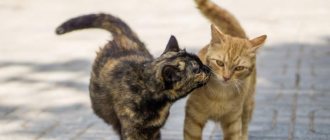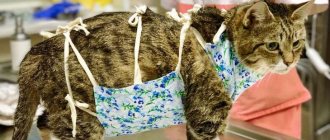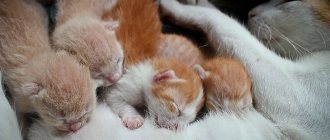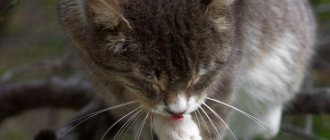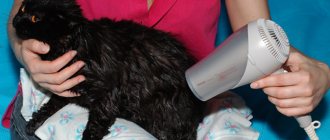Each cat begins puberty at a different time. However, this time can be approximately determined. Experts say that a cat reaches full maturity around nine months from its birth. Of course, this is all individual, because such a process can be influenced by the breed of the cat, its place of residence, and health (see how to match a cat with a cat for the first time).
Therefore, someone can be fully formed three months earlier than the specified period, and someone three later. But it is worth considering that such puberty does not mean that a purebred cat is ready to meet a lady.
You can knit a kitten from a year of its life, or even a year and a half.
Typically, breeding cats begin to mate from one and a half years to about six years. Why not longer? Because the pet has produced a lot of offspring throughout its life, and as you know, it must be of high quality. Therefore, the father of such kittens must give them the best and be still full of strength and health.
Naturally, at an older age, an animal cannot have all this and fully pass on the genes to its heirs. It is for these reasons that the “well done father” ends his career. Since we are talking about purebred cats, the owners are concerned about what their offspring will be like and whether they will be able to take them to exhibitions. Therefore, kittens, in fact, should even surpass their father. For this reason, breeders have a specific breeding schedule that must be followed.
Behavior immediately after mating
Regardless of the timing of mating, there are characteristic behavioral traits.
Upon completion of sexual intercourse, the female sharply pushes away the male and shows pronounced aggression towards him. The degree of aggression depends on the character of the animal; it can even fight with the cat; calm behavior is extremely rare. Normally, estrus lasts from 7 days to two weeks. And if productive mating occurred at the beginning (the first 4-5 days), then estrus will not end there, but will last as long as it should. Many people are surprised by how a cat behaves after mating in the first half of estrus: as if nothing had happened. Moreover, during this time she will be ready for other matings.
Although, in rare cases, after active mating, the female may calm down and behave as if the heat has already passed: this happens after nervous stress or sudden hormonal surges, as well as as a result of multi-day mating.
In this case, everything depends on the condition of the female and the timing of estrus. Typically, if a cat's estrus lasts no more than 10 days, then productive intercourse midterm can calm the cat down. With a longer cycle, the increased hormonal levels take longer to return to normal: the cat screams after mating and behaves as it should during estrus. But there will most likely no longer be an active search for the cat.
There is no cause for concern if the cat continues to eat and drink normally: it can rest like this for several days. Active behavior is also possible, which is characterized by a sharp increase in appetite: if the mating process occurred during minor hormonal disruptions and was not accompanied by stress, then the female will naturally try to restore her strength.
READ Diseases of Siberian cats
How to understand that mating (mating) of cats was successful. During mating, the cat fixes the cat’s neck with its teeth,…
Gulena cat: all the subtleties of the process
There is an opinion that a cat wants a cat in the spring, or more precisely, in March. And it is true... in relation to the “correct” cats living “in nature”. Natural laws tell them to walk in the spring, feed their offspring in the warm season, and in the cold, think only about survival. Unfortunately or fortunately, the sleek, mustachioed pets who live in our homes look down on this opinion. A sweet life and a good diet lead to the fact that they are ready to reproduce throughout the summer and autumn months, and even winter.
At what age does a cat start asking for a cat?
What time do cats start walking? It depends on its breed: usually a cat begins to ask for a cat for the first time in the sixth to tenth month of life. However, despite the onset of puberty before the age of one year, she is not always able to give birth to healthy babies at this time. If a cat wants a cat for the first time, it is advisable not to let them meet at least until the age of one and a half years.
Signs of estrus in a tailed “bride”
What signs in an animal's behavior indicate that a cat wants a cat? There are a lot of them, and it’s difficult not to notice the signs that a cat has gone on a spree:
- the cat screams both day and night, trying to run away from the house;
- cannot stay in one place;
- cuddles up to people and rubs against objects;
- calm cats become aggressive, and vice versa;
- rolls on the floor, lifts its tail up or to the side, tramples with its hind legs, as if squatting on them;
- loses appetite or almost refuses to eat;
- noticeable discharge from the genitals;
- urination becomes more frequent.
How often does a cat ask for a cat?
How many days does a cat walk? The duration of her estrus varies from person to person. But the end of this period, when the cat has gone on a spree, does not mean at all that the owners can relax for a long time: if the “bride” did not manage to meet the “groom”, screaming and rolling on the floor can resume after a week or two. And to the question “how many days does the cat ask for the cat?” the exhausted owners answer: “all 365 in a year!” How this looks in practice, look at the video (Alexey Karasev).
How long does a cat walk?
How long does the cat ask for the cat? The duration of estrus is usually from 7 to 20 days. If the “bride” does not become pregnant, then the “wedding requirements” will be repeated every 14-21 days until she is expecting children or the resting season begins. Occasionally, a third option is also possible, the so-called false pregnancy, which postpones the appearance of a new period when the cat wants a cat.
Stages of heat
The estrus process can be roughly divided into four stages.
- The first is called proestrus. It lasts from 1 to 4 days and is characterized by the relative calm of the animal. The beginning of the period when the cat went on a spree is indicated only by quiet throaty meows and obsessive caressing of the owners. The tailed cat is not yet ready to meet a roaming cat.
- The second period, estrus, can last 7–10 days. The female begins not just to scream, but to scream at the top of her lungs. When you stroke her back, she crouches, moving her tail to the side. This means they are ready to mate. If you want to let her have a kitten or several, it is better to bring a male on the 3rd-5th day of estrus.
- In the third period, metestrus, which lasts from 3 to 12 days, the pet that has walked with the “groom” will drive away all applicants. When fertilization does not occur, a false pregnancy may begin, very similar to the real one, but not ending in childbirth. True pregnancy in your pet lasts 60–70 days.
- In the last, fourth period, called anestrus, she calms down.
How to understand that a cat is ripe?
In cats, puberty is determined primarily by the time of their first heat. An attentive owner will not miss the external manifestations of an approaching heat: an increased desire to caress, rub against legs, against furnishings, slight mucus discharge from the genitals.
Interesting materials:
What is artificial intelligence? What is Raskolnikov's Room like? What is shown on 200 rubles? What is shown on the new 200 rubles? What is shown on the 5000 ruble banknote? What is depicted on our coat of arms? What did Rudolf Diesel invent? What do they study at the Faculty of Journalism? What's swinging in the pool? What has more calories: beer or ice cream?
Cats in heat
If males are hypothetically ready to mate at any time of the day or night, then the reproductive system of cats is somewhat more complex and involves adapting the partner to it. In the same case, if we are talking about a planned mating, the owner of the female must adapt accordingly. Preparation for mating will not be successful if the owner of the pet is not aware of the stages of estrus, which we will talk about later.
During estrus, a cat's genitals are in constant tension.
Stages of heat
There are four stages of estrus in cats, and mating can only take place during one of them.
Table. Stages of estrus in cats
| Stage | Description |
| Proestrus | The stage lasts from one to two days and can be called “introductory”. It is characterized by general anxiety of the cat, not supported by any objective reasons. The pet may rub against the owner’s legs or walk with characteristically bent knees |
| Estrus | The stage reserved for the heat itself and lasting one and a half weeks. It is characterized by the entire list of manifestations described in the previous chapter. It is during estrus that the cat is ready for mating, and mating carried out from 3 to 5 days will be most effective. The peak of estrus is often accompanied by a loud meow, which can be mistaken by owners for severe pain. |
| Metaestrus | The stage of gradual attenuation of sexual desire, which can last from two to ten days depending on various circumstances. Despite the gradual "calming" of the cat, she may still experience secretions from the vagina, which soon stops. During metaestrus, it is useless to plan mating, since the cat begins to perceive the cat’s attempts to establish contact with pronounced aggression |
| Anaestrus | The final stage, which involves complete calming of the cat until the next heat. In this state, the pet has absolutely no desire to participate in mating, and any attempts by the owner to change the situation are unsuccessful |
Failure to comply with the correct time frame can lead to various complications such as disruption of the entire reproductive cycle or false pregnancy, which leaves an imprint on the cat’s health. Frequent disturbances of the reproductive cycle lead to such dangerous consequences as:
- pyometra;
- endometritis;
- neoplasms in the uterus.
One of the worst consequences of untimely mating can also be miscarriage and frequent miscarriages in cats.
How to recognize a false pregnancy in a cat and what methods are used to treat this disease can be read below.
False pregnancy in cats
Features of the course
Unlike the human reproductive system, the cat's does not stop its active activity. Accordingly, estrus continues in cats regardless of their age - among felines there is no such thing as menopause. However, with age, periods of estrus gradually shorten, and the pauses between them become longer.
As cats age, estrus occurs less and less frequently.
Continuous periods of estrus do not mean that the cat can be used to bear offspring until death. The most favorable period for pregnancy in females is considered to be from one and a half to six to seven years of age (again, depending on the breed). Both very young and older cats can have a difficult pregnancy, which will present additional and unnecessary difficulties for the owner.
Primiparous animals
The most difficult thing happens with first-time cats. The point is that they should be allowed into mating no earlier than the pet is at least a year old . As for re-mating, everything will depend on exactly how the pregnancy proceeded and what the physiological state of the animal is.
If everything was in order and the pet gave birth well, then you can breed her... about a year after the kittens were weaned (and not from the time of birth, as many people think about it). In situations where the previous birth could hardly be called “easy,” you need to wait at least a year and a half. Why such difficulties?
It’s simple – your pet’s body definitely needs to fully recover. Young cats have a big advantage over their older relatives: the process of uterine involution in them proceeds much faster. The organ returns to its original state faster and better. True, this does not in any way cancel out another problem: primiparous cats (especially those with large fetuses) almost always have serious tears in the mucous membranes of the genital organs. In older animals, in which the birth canal has already been “developed,” such problems arise much less frequently.
It takes at least six months for the genitals to completely return to their original state. Another three months from the moment the kittens are weaned, the body’s hormonal levels return to normal.
Accordingly, it takes about another six months to restore the resources of the cat’s body. Only after this your pet’s body is absolutely ready for a new pregnancy and is able to bear healthy kittens. Failure to comply with this rule often leads to very serious consequences.
Important! I would like to warn cat owners against the uncontrolled and unjustified use of hormonal drugs intended to stop sexual heat in animals.
They are prescribed only as a last resort and only on the recommendation of a veterinarian. It’s definitely not worth feeding a young cat with them, as there is a high probability of cancer of the reproductive system later. It is better to lock the “violent” pet in a separate room, and/or use natural sedatives (consult your veterinarian about this).
It is also necessary to take into account the “fertile” characteristics of the cat’s body. If there is a cat within reach, the estrus of an animal that has just given birth may begin... on the third or fourth day from the moment the kittens are born. And the trouble here is not only that a newly pregnant cat often stops milk production: it’s much worse that she may well eat the kittens.
In addition, pregnancy at a time when the body has not yet fully recovered from the previous one will not improve your pet’s health in any way. This is especially true for purebred cats (Persians and Siamese). If an animal that is a representative of these breeds is bred with the frequency of a field mouse, your pet will not last long. And the health of the kittens born will get worse and worse each time...
Breeders of Scottish cats also agree with the opinion that long-term rehabilitation of animals is necessary before mating again. This opinion is based on practical results. It is believed that it takes at least eight months for the tartan to fully recover.
At what age do cats start walking? Statistics
Average data states that the need for male attention arises in cats at seven to ten months.
Physiological maturity in cats occurs at the age of eight to ten months. Rarely does this process last up to a year. If your pet goes on a spree at seven to nine months, don’t rush to breed him! Physiological and actual maturity are completely different concepts.
The phase of puberty in cats varies between 6-9 months; in some individuals, the timing may shift upward by several months. In any case, the first heat should begin before the age of 1 year; later it is considered an unhealthy deviation. It’s not at all difficult to understand that a cat has begun to “want”.
The onset of estrus is characterized by the following signs:
- Loud purring, turning into guttural calling cries.
- Frequent urination, reluctance to go to the litter box, marking the territory.
- Adopting characteristic poses with squatting on the front paws and protruding the tail upward.
- Excessive affection: following on the heels of the owners, “wiping” around the legs, excessive affection.
- Swelling of the genitals, accompanied by clear discharge. As a result, the cat begins to lick itself more often.
- Decreased appetite up to its complete loss.
- The desire to escape from home, interest in open doors and windows.
The listed signs can manifest themselves either partially or complexly, making the life of the people around them simply unbearable.
Important: there is the concept of “erased estrus”, when the animal, on the contrary, does not experience any visible symptoms characteristic of the heat stage. In such cases, it is recommended to consult a veterinarian to find out whether this indicates some kind of disorder in the body or is simply a consequence of a weak temperament
It is important to understand when a cat becomes sexually mature. Veterinarians believe that this occurs as early as 6–7 months of age, with females starting puberty much earlier than males.
There are a number of factors that influence exactly when a cat starts walking:
- diet of the animal;
- climate;
- habitat.
It is believed that short-haired animals mature much earlier than long-haired animals. If we talk about periods, that is, the number of days, then on average for each cat this happens at least 2 times a year. This is a rather arbitrary indicator, since in most cases the process occurs much more often.
Typically, cats' first heat begins in early spring. This is especially true for outbred animals, because they have such a periodicity inherent in nature. Therefore, if a pet was born in autumn or winter, it may want to go for walks when it has barely reached six months of age.
It would seem that only recently the fluffy little ball was playing with a ball of thread, but after 6 - 8 months of life, the cat has entered puberty and is ready to become a mother. Around this time, the owners are faced with the animal's first heat. It is difficult to notice an estrus, the symptoms lie exclusively in behavior - excessive affection, persistent cries, the cat fawns, takes a characteristic position for mating (falls on its front paws).
It is difficult to answer the question of how long cats walk, especially for the first time, with specific numbers. Each animal will have its own characteristics. Which can only be calculated by observing the sexual cycle of your pet. In addition, one cannot ignore environmental conditions, namely the nature of nutrition and maintenance, and the breed of the cat.
How many times do cats go for walks? In animals that live outside or older pets, the onset of estrus is associated with the seasons, usually spring and autumn. For cats that constantly live in an apartment and do not leave its confines, or take short walks in the country, more frequent estrus is typical, which can be explained by comfortable living conditions. The average interval between estrus in a healthy animal is 15–25 days, but there are exceptions and features.
Termination of heat
You should know that a cat is capable of childbearing throughout its life, since it does not have a menopause. After 7-8 years, the anestrus phase increases, and estrus can occur only 2-3 times a year.
At this time the risk increases:
- birth of non-viable or weak offspring;
- inability to independently give birth to kittens;
- the development of osteoporosis and osteomalacia due to the leaching of large amounts of calcium and phosphorus from the bones;
- uterine prolapse and the occurrence of other pathologies during childbirth.
Non-standard cases
It happens that after giving birth a cat refuses her cubs and becomes aggressive towards them. In this case, the kittens are transplanted to another nursing mother cat, having previously rubbed them with her milk. If this is not possible, babies are fed artificially from a nipple or pipette, protecting them from the cold and changing the bedding.
Cow's milk and baby food are not close in composition to cat's milk. If possible, kittens are given a mixture of 2 tablespoons of concentrated milk, 2 tablespoons of boiled water and ¼ teaspoon of glucose. The temperature of food and water should be 38 degrees. If the kitten does not eat, moisten its face with food. The eyes are washed with tea leaves.
When giving kittens to a new family, owners are informed about the habits of the cubs, as well as about the vaccinations and treatments performed.
Nowadays, cats of some breeds are popular. Let us dwell on the issues of their reproduction.
How does a female behave after mating?
Ideally, the cat becomes pregnant, carries and gives birth to healthy offspring. But this doesn't always happen. Let's consider some points.
Mating cats
A female is in heat after mating has taken place. Quite an ordinary situation. This all happens because during estrus, a cat produces a considerable amount of sex hormones, and in order for the body to return to normal, it is necessary to wait several days. Even after insemination, an animal can ask for a cat; in this case, it is necessary to focus on him: if the cat has lost interest in his partner, then pregnancy has occurred.
You cannot repeat mating if a seventy-day break has not elapsed since the last intercourse. In this case, the cat can become pregnant again, and if this happens, either the youngest litter dies, or the eldest is born first, and after some time the youngest.
Vomiting, diarrhea after intercourse. It may be a consequence of simple stress from changing places, or a reaction to new food, or the first signs of an incipient abortion.
False pregnancy
Signs of a false pregnancy are swollen nipples, rounding of the abdomen, and cautious behavior. When the pregnancy is resolved, milk comes to the female
The cause of false pregnancy is most often a disease of the cat: a small number of sperm or their low motility.
Behavior after mating varies. A cat can hide in a secluded corner and practically not leave it for several days, and maybe even eat for several days with a clearly increased appetite. The animal needs to restore its strength after mating and gain new strength to maintain the pregnancy; at this time, the cat does not need to prohibit anything, its body knows exactly what needs to be done.
The cat is limping, meowing in pain, and has difficulty changing positions. This may be the reason that the cat injured the female during mating, there is nothing wrong with this, this behavior will quickly go away as the wounds heal.
Optimal mating times
Experienced breeders say that a cat should be bred 3 times a year, that is, approximately 2 months after giving birth.
It is important to know! A cat can go into heat even during lactation.
But during this time it is necessary:
- Conduct a full examination by a veterinarian to identify hidden pathologies;
- ensure the replenishment of calcium, phosphorus, iron and other minerals spent on the formation of fruits and feeding of the young;
- carry out vitamin therapy.
When does puberty begin in cats?
For owners of females, the problem of mating their pet becomes relevant already at 6-7 months of their pet’s life: it is at this time that the cat begins her first heat. Of course, cats should not be mated at this moment, because the animal is still developing (and puberty and physical maturation are not the same thing!), but even then you need to think about future searches for a partner.
The situation is similar for owners of males: cats mature by 7-8 months, but if at this age castration is quite appropriate, then cats do not yet need mating: the animal is not yet ready for it!
If you don't know how old your pet is, the onset of puberty can be determined by certain changes in his behavior. In cats this manifests itself in:
- the appearance of more characteristic behavior (if previously the kitten was affectionate and gentle, now it may become a little aggressive),
trying to mark territory,
attempts to adapt various soft things for their sexual needs.
The signs of maturation in a cat are as follows:
- loud inviting meow,
changes in gait (during heat, the cat raises its tail and arches its back),
rolling on the floor
changes in character - some cats become more aggressive, and some, on the contrary, become affectionate.
When should you think about mating?
As a rule, the first mating of cats should occur at least after the animal is one and a half years old. A female, for example, can be “introduced” to a partner only when she has gone through 2-3 heats, but the ideal age of a cat for mating is one and a half to two years. By this time, the animal will have time to fully develop, and you will have time to give it all the necessary vaccinations. Remember two rules:
- mating of cats should not be carried out during the first heat, even if it comes late (this can end very unfavorably for the animal!),
two weeks before mating, the animal should not be given any vaccinations.
Also, you should not delay the mating itself: this can lead to various anomalies (exhaustion of the animal, disruption of the estrus cycle, or even the development of polycystic disease), so it is better to take care of selecting a partner for your pet, regardless of whether you want to do it!
Should you give your cat birth control?
This is a very important issue that requires separate consideration. Many cat owners consider such medications to be an alternative to sterilizing their animal, but this is not true: contraceptives cause irreparable harm to your pet! In particular, they can cause:
- the appearance of neoplasms in the uterus,
- the occurrence of ovarian cysts,
- hormonal imbalances.
In this case, pathologies of the reproductive system can occur only after a few years, when the cat is already elderly, and you will have to either decide on a risky operation or euthanize the animal. Therefore, if you do not want to endure regular heat and the cat’s behavior after mating, it is better to immediately sterilize your pet, which will not only save you from the hassle of organizing mating, but will also protect your cat from serious and dangerous diseases.
Frequently asked questions about mating a cat and a male cat
The most suitable time for mating a female cat is the dark time of the day. Cat breeders know that it is necessary to treat this process with great trepidation. The duration of sexual intercourse is several minutes, but the very acquaintance of animals with each other and their adaptation to a new territory can usually last a very long time. Stray cats, unlike domestic cats, find males within a few hours.
Need for mating
Every cat owner faces a dilemma: to sterilize or breed their pet. If you plan to get offspring from a cat, you should not give her pills that suppress the desire to mate. These medications are only suitable for pre-neutered dogs, but should only be taken three or four times. After all, these drugs affect changes in hormonal levels, which will damage the reproductive system. Their long-term use can cause disruption or complete disappearance of estrus in females, a feeling of aggression towards the opposite sex, and also cause severe harm to the health of the animal.
For your information! If you do not bring an animal that has not been sterilized, there is a risk that it will behave aggressively, mark its territory, and refuse to eat.
Frequency
Quite healthy cats can mate several times a week, but this does not lead to good results. If you breed an animal frequently, there will be less sperm, its quality will deteriorate, and the female’s chance of becoming pregnant will decrease.
Veterinarians advise breeding cats once a month for the birth of healthy and beautiful offspring in the future.
At what age can you do it for the first time?
Breeders should not delay breeding. Late mating for cats can cause a variety of problems for them:
- polycystic disease;
- inflammation of the uterus;
- false pregnancy;
- stress;
- exhaustion.
Note! A cat is fully sexually mature at around 7-10 months, when she goes into heat. It lasts from 7 to 12 days
But it’s too early for an animal to conceive, since the body is not yet ready for these stresses associated with pregnancy. If you fertilize a young cat early, it will have a bad effect on the reproductive organ and pose a threat to her life. The best age for mating females is from one year. Males can be mated from six months of age; from this period they are fully mature for breeding.
Why do cats scream?
How cats make love to a cat is very difficult not to hear. Before mating, representatives of the feline breed experience a change in hormonal levels. At this stage, pathogens are produced that affect the cat’s behavior. In science, this initial phase is called estrus. It is accompanied by a very loud meow in females in order to attract a partner.
Why do cats scream during mating?
During mating, cats experience severe pain as their uterus is irritated by scales located on the male's genitals. This is necessary to stimulate ovulation, which begins within 24 hours after the end of mating. The resulting pain causes her to scream loudly and strongly.
Why is it so important to spay your cat?
Unless you want to open a kitten breeding business, you need to make sure your precious cat doesn't turn into a breeding machine.
You can avoid contact with any cat unless you want to care for dozens of kittens every year.
However, sterilizing the cat is the best option, although many owners are against it. In fact, sterilization is an act of love. Not only will you have a cat with less mood swings, anxiety and stress due to any heat, but you will also reduce the likelihood of your pet running away from home. Plus, this way you won't have to worry about finding a kitten-safe roof. Irresponsible breeding often leads to the appearance of colonies of feral cats on the street.
The right age for mating
The average age of puberty in a cat is 5-9 months. At this time, the first heat occurs and the animal acquires the ability to reproduce. At the same time, the growth and development of the body ends at 12 months (in large breeds - at 1.5 years).
At the age of 1 year, the skeleton is already fully formed, the ears stand well and the animal is in the desired condition. Hormones necessary for gestation and birth of offspring stop the growth of the animal. Therefore, cats mated during their first estrus remain smaller throughout their lives.
In this regard, breeders recommend skipping the first 2 heats, allowing the pet to fully form, mature and turn into a shining example of its breed. In addition, only those Scottish cats that have received high marks at specialized exhibitions are allowed to breed.
Preparing a kitten for a show career begins immediately after the post-vaccination quarantine. And a Scotsman gains the minimum permissible number of examinations only at 1.5-2 years. Thus, the first registered mating of a pedigree cat, both for veterinary and felinological reasons, cannot occur earlier than this age.
Features of mating purebred cats
Owners of purebred cats should approach the choice of a partner for mating responsibly - this determines what the offspring will be like. To prevent kittens from inheriting breed defects, you need to choose an ideal mother for them. A “pure” pedigree in a cat will guarantee the absence of physical and genetic abnormalities in the offspring. For successful mating, it is good if both parents have outstanding sires in the family. Specific rules for breeding animals are established by the clubs themselves.
When breeding purebred animals, their blood types must be taken into account so that the kittens do not develop hemolysis, a deadly disease. Therefore, carefully study the compatibility of animals according to this factor. For example, if a cat has group B, then he can be bred with any cat, and if he is A, then mating with a cat with group B is excluded, etc. Don't know your blood type? Then it is worth taking the appropriate test from a veterinarian in advance.
If your cat participates in exhibitions, then take into account their schedule. It is better to breed an animal after an exhibition so that the appearance of the pet does not let us down, since matings directly affect the exterior (coat quality, etc.).
Rules
The success of mating a cat and a cat depends on the correct execution of the process by the animals. The cat owner is responsible for mating. It is he who is responsible for both animals.
Due to the cat's aggressiveness, she is brought into the male's territory. Animals are placed in a clean room and left there alone. The presence of strangers is undesirable, as they can frighten off the partners.
First, the pets must get to know each other. At first, the female usually hisses at the male, but over time she lets him in. The sexual contact itself does not last long - less than a minute. Often, conception requires the cat to cover the cat several times. Therefore, partners should stay in the same room for 2–3 days.
If the female does not let the cat near for a long time, she needs to be calmed down (for example, stroked). In a situation where the male does not pay attention to the cat, he must be replaced, since mating most likely will not occur.
By following the above recommendations, you can significantly increase the effectiveness of mating and get healthy offspring.
First mating of male and female: age, behavior, problems and solutions
When the mating of a cat and a cat is planned for the first time, the owners are overcome with anxiety. My head is spinning with questions: how do you know if you are ready for mating? How long does the contact last? Did you get pregnant after a date?
The admonitions of friends - “instinct will take its toll”, “nature has provided for everything” - do little to reassure. Felinologists say: the first controlled mating of a cat and a cat, in contrast to a free one, is a responsible matter. Owners of newlyweds should thoroughly prepare for this event.
Is it possible to breed the Canadian and Don Sphynx?
Despite the great similarity, the Canadian and Don Sphynx are so genetically different that crossings between them are prohibited.
Interesting materials:
How to prepare liver for frying? How to prepare the soil for pepper seedlings? How to prepare a Tefal frying pan for use? How to prepare a bathtub for painting with enamel? How to prepare for a 10K run? How to prepare for a 1KM cross-country race? How to prepare for a trip to the urologist? How is the RCD connected? How to connect a 3-phase socket? How to connect free digital television 20 channels?
Dog mating: how it goes
Mating is a natural process embedded in genes and instincts. In most cases, animals cope well with this on their own, without the help of their owners or instructor. The exception is small breeds, which, due to physiology, more often need help in fulfilling their parental duties.
Preparation
The ultimate goal of breeding dogs is to produce healthy offspring, so each of the future parents should visit a veterinarian before mating. If the intended mating and subsequent pregnancy span the period of mandatory annual vaccination, it is necessary to consult a doctor and shift the schedule so that the bitch’s body has time to recover after vaccination. Two weeks before mating, dogs are treated prophylactically for worms.
It is recommended to prescribe mating in the morning. Before the act, the animals are given a good walk, but not fed, or fed just a little. Geographically, the meeting is scheduled at the dog’s home. The male must feel like he is in charge.
It is important to create a calm environment in which nothing will distract or frighten partners. Dogs need some time to get used to each other.
If the mating will take place in an apartment, provide lovers with enough space to play and look closely. Remove anything that animals could drop or break.
If the bitch is ready and in the mood for mating, she will calmly let the male in. Inexperienced girls often behave nervously and even aggressively towards their partners. If you did not guess the ovulation period, such an attempt will be fruitless. If it's all about attitude, the dog's experience and your ability to calm your ward will play a big role.
Technology and assistance
In nature, the process of mating dogs is not much different from human reproduction.
After introduction, a short foreplay in the form of games and sniffing, the male climbs onto the bitch from behind (therefore it is important that she is ready, pulls her tail back and stands calmly). Cynologists call reciprocating movements cages
The penis must enter the vagina and inject sperm. At this moment, there is a maximum rush of blood to the bitch’s genitals, they swell and hold the male’s penis.
The so-called lock in dogs during mating or mating can last from several minutes to an hour. Don't worry - this is a natural stage of mating. It happens that gluing does not occur. This may be a warning sign that the mating has failed. Often such acts still end in pregnancy, but in this case, repeated mating after a day or two becomes more important.
After a successful act, the dogs are bred. Both owners should inspect their animals to make sure there are no injuries or other problems. It is better to wash the genitals immediately.
During breeding, the dog often needs help to become more comfortable.
The owner or mating instructor carefully throws the dog's paw over the bitch's croup so that the animals are facing each other with their backs
It is important to do this as tactfully as possible so as not to scare the dogs. If the bitch tries to lie down or move away, gently but persistently hold her until the genitals are separated.
Help in this natural process is often necessary for small breed dogs - toy terriers, Yorkshire terriers, chihuahuas. Sometimes pugs and bulldogs need it, and among large breeds - Great Danes. The reason for the “lack of independence” of these animals, as you might guess, is the discrepancy in the size of the partners.
If the male is rather short, you can help him by placing a pillow, a blanket folded several times, or something similar under his paws. If the bitch is too short, she is placed with her stomach on the owner's knee. It is strictly forbidden for a bitch to bend her hind legs - this can lead to injuries for both partners.
Useful tips for pet owners
What about hormonal drugs? We haven't forgotten about them, of course. However, following the advice of veterinarians, we recommend using them only in exceptional cases. It should be understood that regular use of them causes metabolic disorders in animals. And it already manifests itself in the form:
- inflammation in the organs of the reproductive system;
- problematic pregnancy;
- weak or sick offspring;
- difficult births leading to caesarean sections;
- tumors of the mammary glands and uterus, including malignant ones.
This is why responsible specialists prefer sterilization when owners don’t want to hear about furry children. The advantages of this option for solving the problem of offspring are obvious: you save yourself and your pet from suffering, prevent the dangerous consequences of using hormonal drugs and, in the end, reduce the number of useless defenseless lumps.
However, having decided to sterilize your pet, you should remember that before the operation, they usually need an examination by an experienced veterinarian, and after that - competent and caring care. You also need to find out what she should be vaccinated with. If everything is done professionally and with love, your cat will not be in a state of chaleur, warming the house with its love for many, many years.
Loading …
When breeding purebred cats, every animal owner must be aware of the full degree of responsibility for the future offspring. Your cat or cat should eat well. Therefore, it is necessary to feed your pet only the most natural and high-quality food. This could be meat, vegetables, sea fish or premium ready-made food.
Owners of cats should understand that they should not tire the animal with too frequent mating. Although a healthy sexually mature cat is in constant readiness to impregnate a cat, frequent mating can cause a deterioration in the quality of sperm, which will affect the condition of the offspring. Therefore, you need to bring the cat at least with breaks of one week.
Before taking a cat for mating, you should not give the animal any sedatives. When trying to reduce your cat's stress level, you may accidentally stop the cat's heat and ruin the entire procedure. Of course, any trip will be a shock for a pet. But it is better to calm your pet with a gentle voice, rather than with drugs.
Reasonable bathing after childbirth
Bathing is not a necessary part of regular cat care. Frequent exposure to water and detergents disrupts the functioning of the sebaceous glands. Signs of flaking and dandruff appear on the skin, the coat becomes dull and brittle. Therefore, you should resort to this hygiene method no more than once every 2 months.
Bathing a cat 10-15 days after birth is indicated in the following cases:
- in case of significant wool contamination that cannot be eliminated by other means;
- with excrement and other impurities stuck to the fur while being outdoors;
- if there is an unpleasant odor.
When controlling fleas in cats after birth, the use of insecticidal preparations is prohibited. Therefore, to get rid of ectoparasites, it is enough to place the animal in water, wetting the fur up to the neck area. Next, immobilized parasites should be selected with a thick comb or by picking through the hairs with your hands.
What are the risks of constant childbirth?
Let us note right away that it is nothing good. Yes, by nature it is “instituted” that the cat’s body is adapted to constant childbirth. Thus, homeless “Murks” often have up to 200 kittens in their entire lives. There are also cases of greater multiple births. It’s just that such cats don’t live long.
Nature provides such fertility for one single purpose - to maintain high numbers of the species. But today, domestic cats are clearly no longer in danger of extinction, so there is no need to turn your pet into a walking “incubator.”
With constant childbirth, , as well as the organs that form the birth canal, suffer Many cats develop uterine subinvolution after three or four years of constant reproduction. Simply put, the organ never returns to normal, resembling a stretched sac in shape. This dramatically increases the risk of developing chronic endometritis and even pyometra.
Veterinary statistics show that especially “productive” cats have a sharply increased risk of developing birth complications. So, if normally the probability of this does not exceed 3%, then for “deserved women in labor” this figure can immediately increase to 20% or more. This is often due to the fact that the stretched uterus almost completely loses its rigidity (that is, the ability to contract). Accordingly, during childbirth she may not push out the kittens.
